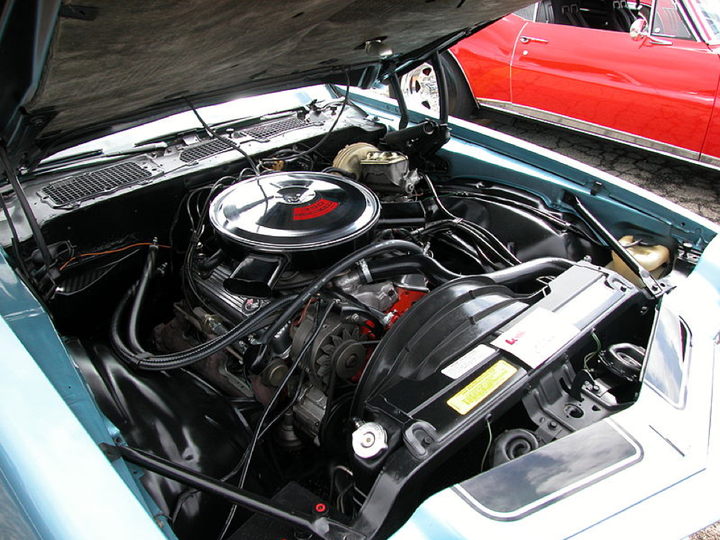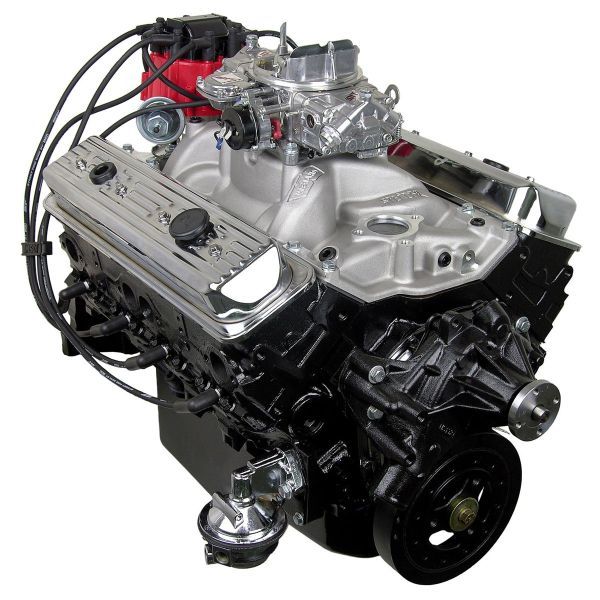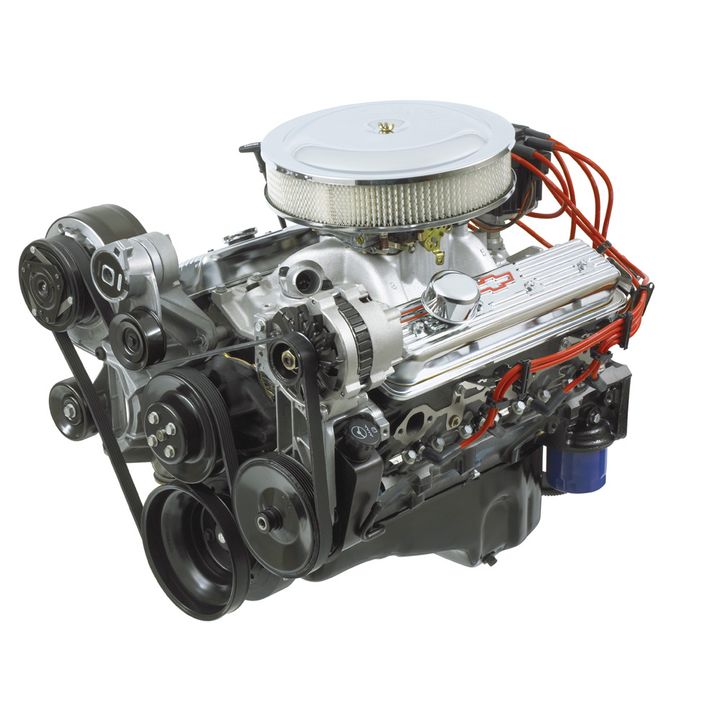


The Chevrolet 350 small-block V8 engine is a true automotive icon, renowned for its versatility, reliability, and raw power. This legendary powerplant has captivated enthusiasts for over five decades, powering countless vehicles from classic muscle cars to modern trucks and SUVs. In this comprehensive guide, we delve deep into the intricate details that define the horsepower potential of the Chevy 350 engine, exploring its specifications, variants, real-world performance, and the art of extracting maximum power through modifications.

Introduced in 1967, the Chevy 350 engine quickly established itself as a force to be reckoned with in the automotive world. Its compact yet robust design, featuring a displacement of 350 cubic inches (5.7 liters), made it a popular choice across a wide range of applications.
| Engine Specification | Value |
|---|---|
| Displacement | 350 cubic inches (5.7 liters) |
| Cylinder Configuration | V8 |
| Cylinder Bank Angle | 90 degrees |
| Bore | 4.00 inches |
| Stroke | 3.48 inches |
The 350's V8 configuration contributed to its smooth and linear power delivery, while its cast-iron construction ensured durability and longevity. One of the key factors that set the 350 apart was its broad torque curve, providing ample low-end grunt and responsive throttle response. This characteristic, combined with its iconic sound and abundant aftermarket support, solidified the 350's status as a beloved platform among enthusiasts and builders alike.
The horsepower output of a 350 engine can vary significantly depending on the specific model year, engine configuration, and vehicle application. According to industry data, the horsepower range for a stock 350 engine typically falls between 145 and 370 horsepower.
| Compression Ratio | Horsepower Range |
|---|---|
| 8.25:1 | 145 - 195 hp |
| 9.0:1 | 165 - 230 hp |
| 10.25:1 | 235 - 300 hp |
| 11.0:1 | 285 - 370 hp |
It's crucial to note that these figures are approximate, and the actual horsepower may differ based on various factors, such as compression ratio, camshaft specifications, cylinder head design, and fuel delivery system.
While the 350 engine's inherent design and specifications laid the foundation for its performance, several key factors influenced its ultimate horsepower output. Understanding these factors is essential for enthusiasts seeking to maximize the engine's potential.
The compression ratio, which measures the ratio of the cylinder volume when the piston is at the bottom of its stroke to the volume when the piston is at the top, played a crucial role in determining the 350's horsepower. A higher compression ratio resulted in increased cylinder pressure during the combustion process, translating into greater power output.
However, it's important to note that higher compression ratios also require higher-octane fuel to prevent engine knock and potential damage. Striking the right balance between compression ratio and fuel quality is essential for optimal performance and longevity.
The camshaft, responsible for controlling the opening and closing of the engine's valves, had a profound impact on the 350's horsepower and torque characteristics. Engines equipped with more aggressive camshaft profiles, featuring increased duration and lift, tended to produce higher horsepower figures due to improved airflow and valve timing.
| Camshaft Specification | Effect |
|---|---|
| Increased Duration | Longer valve opening, improved airflow |
| Increased Lift | Greater valve opening, improved airflow |
| Advanced Timing | Earlier valve opening, increased power at higher RPMs |
| Retarded Timing | Later valve opening, increased low-end torque |
However, it's important to note that more aggressive camshaft profiles may also result in increased noise, vibration, and potential wear on other engine components, requiring complementary upgrades and proper maintenance.
The design of the cylinder heads, which housed the valves and combustion chambers, significantly influenced the 350's power potential. Efficient cylinder head designs, such as the Vortec iron heads found in some variants, optimized airflow and combustion, resulting in increased horsepower and torque output.
| Cylinder Head Design | Advantages |
|---|---|
| Vortec Iron Heads | Efficient airflow, improved power potential |
| Aluminum Heads | Lighter weight, better heat dissipation |
| Raised Runner Intake | Improved airflow, increased high-RPM power |
| Larger Valves | Increased airflow, higher power potential |
Choosing the right cylinder head design for your specific performance goals and engine configuration is crucial for maximizing the 350's horsepower output.
Throughout its production run, Chevrolet introduced several high-performance variants of the 350 engine, each offering unique characteristics and power outputs. These variants catered to the demands of performance enthusiasts and showcased the engine's versatility.
L46
Introduced in 1969
High-performance camshaft
Four-barrel carburetor
Optimized cylinder heads
350 horsepower at 5,600 RPM
380 lb-ft of torque at 3,600 RPM
LT-1
Offered in various model years
Horsepower ratings ranging from 250 to 370 hp
Popular choice for exceptional performance without compromising reliability
Crate Engines
Chevrolet Performance offers factory-built crate engine options
Example: 350 HO Base crate engine
333 horsepower
381 lb-ft of torque
Convenient and reliable solution for upgrades or replacements
While the advertised horsepower figures are undoubtedly impressive, it's essential to consider the 350 engine's real-world performance and fuel economy. According to user reports and independent testing, a well-maintained 350 engine in a typical passenger vehicle can achieve fuel economy figures ranging from approximately 12 mpg in city driving to around 16 mpg on the highway.
However, these numbers can vary significantly based on several factors:
Vehicle weight
Gearing ratios
Driving habits
Modifications and upgrades
It's worth noting that modifications and upgrades aimed at increasing horsepower may adversely impact fuel economy, requiring careful consideration and balancing of priorities.
For enthusiasts seeking to extract even more power from their 350 engines, a wide range of modifications and upgrades are available. These enhancements can significantly increase horsepower and torque output, but they should be approached with caution and proper guidance to ensure safe and reliable operation.
One of the most popular modifications for the 350 engine is the installation of high-flow headers. These aftermarket exhaust components replace the restrictive factory exhaust manifolds, allowing for improved exhaust flow and increased horsepower and torque.
| Header Upgrade | Potential Gains |
|---|---|
| Long-Tube Headers | Up to 15% horsepower increase |
| Shorty Headers | Up to 10% horsepower increase |
It's important to note that header installation may also require complementary upgrades, such as high-flow exhaust systems and tuning, to fully realize the potential gains.
Swapping out the stock camshaft for a more aggressive performance camshaft can dramatically improve the 350's power and responsiveness. However, this modification often requires complementary upgrades, such as upgraded valve springs and lifters, to accommodate the increased valve lift and duration.
| Camshaft Upgrade | Potential Gains |
|---|---|
| Mild Performance Cam | 10-20% horsepower increase |
| Aggressive Performance Cam | 20-30% horsepower increase |
It's crucial to carefully select the appropriate camshaft profile based on your specific performance goals and engine configuration, as well as ensure that all necessary supporting modifications are made to avoid potential engine damage.
Upgrading the intake and exhaust systems with high-flow components can further enhance the 350's power potential. These modifications improve airflow and reduce restrictions, allowing the engine to breathe more efficiently and generate higher horsepower and torque figures.

Intake System Upgrades
Cold air intake
High-flow air filter
Throttle body upgrade
Intake manifold upgrade
Exhaust System Upgrades
High-flow catalytic converters
Dual exhaust system
Muffler delete or high-flow mufflers
It's important to note that these upgrades should be carefully selected and installed by experienced professionals to ensure proper fitment, compatibility, and optimal performance gains.
The Chevrolet 350 small-block V8 engine has earned its place as an iconic and versatile powerplant, captivating generations of automotive enthusiasts. With its robust construction, efficient combustion process, and broad torque curve, the 350 has proven its mettle in a wide range of applications. By understanding the factors that influence its horsepower output, such as compression ratio, camshaft specifications, and cylinder head design, enthusiasts can make informed decisions when building or modifying their 350 engines to achieve their desired performance goals. Whether seeking pure power or a balance of performance and fuel economy, the 350 engine remains a beloved platform that continues to inspire and excite automotive enthusiasts worldwide.
The Chevy 350 refers to the classic small-block V8 engine, while the 350 Vortec is a later generation of the small-block with improved cylinder heads and fuel injection. The Vortec engines were introduced in the late 1980s and offered better performance and efficiency.
A higher compression ratio results in increased cylinder pressure during combustion, allowing the engine to produce more horsepower. However, higher compression ratios also require higher-octane fuel to prevent engine knock.
Upgrading to a performance camshaft with increased duration and lift can significantly improve the engine's airflow and valve timing, resulting in higher horsepower and torque output. It is a popular modification for extracting more power from the 350.
Efficient cylinder head designs, such as the Vortec iron heads or aluminum heads, optimize airflow and combustion, allowing the engine to produce more power. Larger valves and raised runner intakes can also contribute to increased horsepower.
Notable high-performance variants include the L46, LT-1, ZQ3, and L82/L98. These engines featured performance-oriented components like high-flow cylinder heads, aggressive camshafts, and higher compression ratios.
According to user reports and independent testing, a well-maintained Chevy 350 engine in a typical passenger vehicle can achieve fuel economy figures ranging from approximately 12 mpg in city driving to around 16 mpg on the highway.
Installing high-flow headers replaces the restrictive factory exhaust manifolds, allowing for improved exhaust flow and increased horsepower and torque. Long-tube headers can provide up to a 15% horsepower increase.
Upgrading to high-flow intake and exhaust components, such as cold air intakes, high-flow air filters, and dual exhaust systems, can improve airflow and reduce restrictions, allowing the engine to generate higher horsepower and torque.
Purchasing a Chevy 350 crate engine from companies like Mr. Goodwrench or Summit Racing can provide a convenient and reliable solution for engine upgrades or replacements, with various configurations and performance levels available.
The Chevy 350 small-block V8 is considered an iconic and versatile powerplant that captivated generations of automotive enthusiasts. It was widely used across various GM divisions and vehicles, earning a reputation for durability, performance, and reliability.

Sarah isn't your average gearhead. With a double major in Mechanical Engineering and Automotive Technology, she dived straight into the world of car repair. After 15 years of turning wrenches at dealerships and independent shops, Sarah joined MICDOT to share her expertise and passion for making cars run like new. Her in-depth knowledge and knack for explaining complex issues in simple terms make her a valuable asset to our team.












